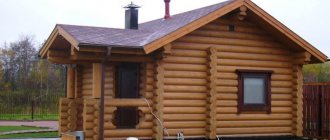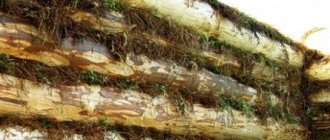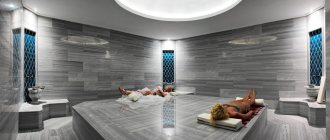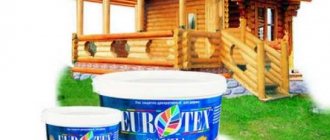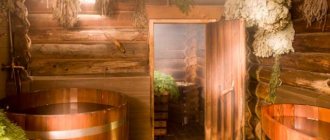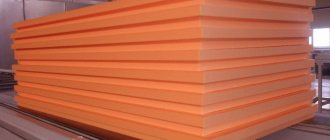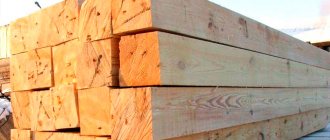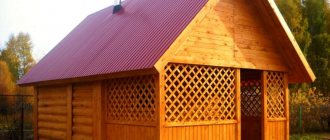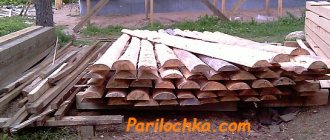The construction of a Russian bathhouse is traditionally carried out from wood of various species. But not all types of wood are suitable for building a bathhouse, so it is important to understand and understand which ones are better to choose. What kind of wood is best to build a bathhouse from, which one is suitable for finishing, we will find out why with our readers.
The wood for building a bathhouse is different. Each has its pros and cons.
Qualities of pine logs
This species has a wide growing area, second only to larch, which, combined with the properties of its wood, makes it the most popular material for log bathhouses. Pine has a high yield of industrial wood, and burs predominantly produce smooth, even trunks. The core of the tree is red-brown in color, and the outer layers are light yellow.
Advantages of pine:
- High strength with low weight;
- Ease of processing;
- Minor shrinkage without cracking;
- Not a very high concentration of resins;
- The property of releasing beneficial essential oils with a pleasant aroma when heated;
- Reasonable price.
The disadvantages of pine include some difficulty in impregnation with protective compounds due to the content of resins in the wood.
Interior decoration - which wood is better?
In a Russian bath, wood is used not only for the construction of a log house, but also for interior decoration. Baths assembled from foam blocks or bricks can be refined from the inside. Wood will make the bathhouse natural and environmentally friendly.
Traditionally, wood is used in interior decoration, which is resistant to moisture and high temperatures. So, pine and spruce are not suitable for interior decoration. Deciduous woods are used: linden, oak, aspen.
A bathhouse decorated inside with linden lining will be pleasant at any high temperature.
Linden in interior decoration showed its best side. Even at the highest temperatures, the walls and ceiling will be tactilely pleasant. Linden has a drawback: it darkens over time. After finishing with clapboard, the bathhouse is covered with antiseptic and fire-resistant compounds.
Aspen and oak are used less frequently in bathhouse decoration due to the high price of the material. But if you want to have a rich environment, oak and aspen are optimal. In order to save money, oak and aspen lining is used as an additional option in order to emphasize some details. For example, often the canopy is lined with linden lining, and the headrest and backrest are made of oak.
It is very useful to use cedar elements in the steam room. The aroma of cedar has a healing effect. But it can cause allergies in young children. A completely cedar bathhouse looks attractive, let’s take a closer look at this one in the video:
Any tree, expensive aspen, larch, or economical spruce and pine are suitable for building a log bathhouse. It is impossible to answer clearly which wood is best to build a bathhouse from. One wood is used to assemble the log house, the other inside the bathhouse. The choice depends on the capabilities of the owners. And proper care of wood will help to significantly extend the service life of the steam room.
Properties of spruce logs
Practical and economical for construction, this breed is quite widespread. To the east of the Urals grows Siberian spruce, to the west - European spruce, which practically do not differ in quality. The cut wood has a pinkish or yellowish tint and exhibits annual rings of varying thickness.
Advantages of spruce:
- Quite durable, soft wood with low weight;
- Good heat saving properties;
- Durability of structures;
- Releases a pleasant and distinctive resinous odor when heated.
Disadvantages of spruce logs:
- Quite significant shrinkage, which over time can provoke the appearance of deep cracks;
- The trunks are not as straight as those of pine;
- Many branches and twigs;
- Abundant content of resins that are released to the surface for a long time.
Prices for spruce log houses (2021)
| Log size | Cost of the set, rub. | Log frame in a bowl, rub. | Aspen log house (surcharge, rub.) | Additional crown in the paw (cutting + 20 cm), rub. | Veranda 2 m (on the short side), rub. | Veranda 2 m (on the long side), rub. | Gable, mansard roof with ridge 3.5-4.0 m | Sloping roof with a ridge 3.5-4.0 m high, ceiling height in the attic 2.2-2.5 m. |
| 3*3 | 230 000 | 322 000 | 11 000 | 11 000 | 40 000 | 40 000 | 40 000 | 50 000 |
| 3*4 | 240 000 | 336 000 | 14 500 | 14 500 | 40 000 | 40 000 | 45 000 | 55 000 |
| 3*5 | 250 000 | 350 000 | 18 000 | 18 000 | 40 000 | 40 000 | 45 000 | 55 000 |
| 3,5*5 | 280 000 | 392 000 | 21 000 | 21 000 | 40 000 | 40 000 | 50 000 | 60 000 |
| 3*6 | 290 000 | 406 000 | 21 500 | 21 500 | 40 000 | 42 000 | 50 000 | 60 000 |
| 4*4 | 260 000 | 364 000 | 19 000 | 19 000 | 40 000 | 40 000 | 45 000 | 55 000 |
| 4*5 | 300 000 | 420 000 | 24 000 | 24 000 | 40 000 | 40 000 | 50 000 | 60 000 |
| 4*6 | 350 000 | 490 000 | 29 000 | 29 000 | 40 000 | 42 000 | 55 000 | 65 000 |
| 5*5 | 360 000 | 504 000 | 30 000 | 30 000 | 40 000 | 40 000 | 55 000 | 65 000 |
| 5*6 | 420 000 | 588 000 | 36 000 | 36 000 | 40 000 | 42 000 | 65 000 | 80 000 |
| 6*6 | 480 000 | 672 000 | 43 000 | 43 000 | 42 000 | 42 000 | 65 000 | 80 000 |
The kit includes:
- Log house of five-walls with internal protruding of the walls (cutting the corner “into the paw”).
- The diameter of the log is at least 22 cm. Usually it is 24–26 cm.
- Processing logs “for a plane” or “for a scraper”.
- Clear height from floor to ceiling 2.10–2.15 m.
- Floor and ceiling beams made of hewn logs
- Rafter system for a gable roof with a ridge height of up to 2 m (rafters made of round timber).
- Lathing - unedged board 25 mm.
- The log house is assembled on moss and installed on the customer’s foundation.
You can also familiarize yourself with the presented configurations:
“Basic” set
Set “To an empty lot”
"Advanced" kit
Comparative analysis
The thermal conductivity of the materials is approximately the same. In spruce, due to the higher air content in the wood, this figure is slightly higher. But pine walls can be much thicker, since the diameter of the tree trunks of this species is larger.
The durability indicators of spruce are lower due to high moisture absorption, which can provoke the occurrence of fungi, mold, and rotting. The resin content in its wood is lower, and, accordingly, their release into the atmosphere is also lower.
On a note! The evenness and smoothness of the trunks greatly simplifies the processing of pine. The difficulty of working with spruce is due to the knotty nature of the species, but this is compensated by the high decorative qualities of the log house.
Both types of wood darken in approximately the same time, but pine untreated with special compounds gradually acquires a more intense brownish-red hue. This problem can be solved by installing decorative cladding or using special impregnations.
Important! Wood treatment compositions must be safe for health, not melt when heated, and not emit odors or toxic substances!
The ability of spruce to absorb and remove moisture outside causes greater “dryness” of bathhouse structures than those made of pine, which is at the same time subject to “blueing.”
The price of both types of wood is approximately the same, and they can be easily combined provided that healthy raw materials are chosen and the logs are prepared correctly. For example, pine is the optimal material for constructing lower crowns exposed to strong humidity, and spruce is ideal for constructing the upper part of walls, since it has high heat-saving and decorative qualities.
What is better for a bathhouse - spruce or pine? Comparative characteristics
To find out which breed is best to choose for a steam room, let’s compare the properties of each breed.
- The use of both spruce and pine provides a favorable microclimate in the room and retains heat well inside it. But the thermal conductivity of spruce is slightly higher due to the higher air content. At the same time, the thickness of the pine log blanks is greater, due to which this difference can be compensated.
- Spruce is not as durable and is susceptible to fungi, mold and rot.
- The appearance of spruce is more attractive due to the original color, but processing is difficult due to knots and branching.
- Darkening of an untreated log house occurs over the same period of time, while the pine pattern appears more pronounced. To avoid such consequences, it is worth treating the workpieces with special protective agents.
- Spruce absorbs moisture more, so the wood quickly turns blue.
Selection of lumber for construction
The recommended period for purchasing wood is winter, since the logs must be aged for at least a month before construction. If possible, it is advisable to purchase material harvested in the northern regions - it is characterized by maximum density and minimal susceptibility to cracking and rotting.
Signs of quality logs:
- No rot or wormholes;
- Minimum number of knots;
- Evenness of shade;
- Constant diameter along the entire length;
- Clarity of the pattern on the cut;
- Minimum trunk curvature;
- The shade of the core is darker than the color of the outer layers.
Advice! To determine the quality of the log, you need to lightly hit the cut with the butt of an ax - the tool should bounce back, making a ringing sound.
The correct choice of material, along with proper assembly, guarantees that the result will be a durable and attractive-looking log bathhouse with an ideal microclimate for healing the body.
Pine
Pine is a good building material, but it is inferior in durability and durability to larch and cedar. It is quite durable and, if you do not plan to steam in the cold season, you will not freeze in a pine bathhouse. In addition, pine is the most affordable, so very often inexpensive baths are made from pine.
Benefits of pine wood
- Price - pine baths are the most inexpensive
- Strength
- Ease of processing
However, unlike cedar and larch, pine must be treated with antiseptic agents, because it is susceptible to rotting. The upper layers of wood are softer, able to absorb moisture and are especially susceptible to “blueing” of the fabric. Such a bathhouse will not last you long, but as an option for an inexpensive summer bathhouse for 5-7 years, it is quite functional.
Disadvantages of pine wood
- Fragility
- High thermal conductivity - pine baths are “cold” and quickly release heat. You can't steam in winter
- The need for additional treatment with antiseptic compounds
If you plan to steam in a sauna both in winter and summer, then cedar is more suitable. The sauna will serve for a long time, reliably and will help improve the health of the body.
Spruce: advantages and disadvantages
Spruce has almost identical properties regardless of the variety. Common to all is a pink or yellow color on the cut and pronounced annual rings. To build a log house from spruce, you need to familiarize yourself with its characteristics:
Article on the topic: Sauna stove kastor or harvia which is better
- It is easier to build a log bathhouse from spruce logs, thanks to the softness of the log. Spruce logs are light in weight. Spruce has high strength. Low thermal conductivity due to the high air content in the capillaries of wood. A finished spruce sauna lasts a long time.
The disadvantages of spruce lumber include:
- Large shrinkage, which leads to the appearance of deep cracks. The radius of curvature of the trunk is significantly greater than that of pine. Branchiness and a large number of knots. Resin is released to the surface not only during heating.
If a bathhouse made of pine or spruce is not lined with anything from the inside, then during bathing procedures you can stick to the wall because of the resin or get burned by it, so it’s worth thinking about how to treat the inner surface of the bathhouse.
Features of log houses
If a spruce log house has been treated with special compounds, its service life will greatly increase. Spruce is also the most affordable building material, and wins the competition due to its low cost. This material can be used not only for construction and exterior decoration, but also for design decoration of interior spaces, including the manufacture of furniture. This type of wood is also distinguished by bactericidal properties that protect those living in the house from many diseases. In addition, spruce does not cause allergic reactions.
Conclusion
Not only timber made from spruce has negative qualities, but all materials used, without exception. But in comparison with the positive factors, the disadvantages of using spruce in the construction of a bathhouse can be counted on one hand. Therefore, the material is excellent for such structures. A spruce bathhouse is not only practical, but also visually matches the aesthetic component of modern designs.
The feeling you get from using a spruce bath is unique, because no artificial material can convey the aroma of heated spruce. In addition to the positive sensations from using a bathhouse, in many cases spruce has a healing effect on the human body. In addition, the material is convenient in that it can be combined with other building elements of the structure.
